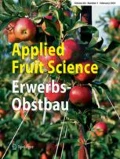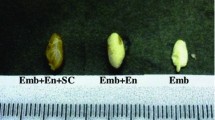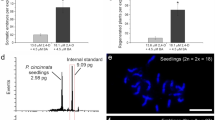Abstract
In vitro embryo culture enabled satisfactory germination of immature seeds produced in crosses from early ripening sweet cherry varieties (Prunus avium L.). Three varieties —‘Rita’, ‘Bigarreau Burlat’ and ‘Carmen’— were crossed with ‘Early Star’ as male parent. Germination rate was affected by the developmental stage of both fruit and embryo. Fruit ripening stage was a critical factor for culture infection rate that increased with maturity. In-ovule embryo culture on Murashige and Skoog medium without hormones improved the embryo size but did not increase the germination rate due to a further increase in infection rate. Ex-ovule embryo culture on Murashige and Skoog medium supplemented with BA 1 mg L−1, NAA 0.5 mg L−1, 20 g L−1sucrose, 10 g L−1 sorbitol and 6 g L−1agar during the stratification time increased embryo length. Germination was performed on Brooks and Hough medium at the 22 ± 1 °C with 16/8 h light/dark photoperiod. The highest germination rate (75 %) was reached in embryos that were 3−4 mm in length, after 30-days stratification at 4 °C. Embryos in fruits at green-yellow stage that were 3−4 mm long were morpho-physiologically developed to produce bipolar seedlings, without combined application of embryo culture and micropropagation.
Zusammenfassung
Die in-vitro Embryonenkultivierung ermöglichte eine zufriedenstellende Keimung von unreifen Samen, die durch Kreuzungen von frühreifenden Süßkirschensorten (Prunus avium L.) entstanden waren. Drei Sorten – ‚Rita‘, ‚Bigarreau Burlat‘ und ‚Carmen‘- wurden mit ‚Early Star‘ als Vatersorte gekreuzt. Die Keimrate wurde sowohl vom Entwicklungsstadium der Pflanze als auch des Embryos beeinflusst. Der Reifegrad der Frucht war ein entscheidender Faktor für die Infektionsrate, die mit der Reife anstieg. Die in-ovule Embryonenkultivierung mit dem Murashige-Skoog-Medium ohne Hormonzugabe verbesserte die Embryogröße, erhöhte aber aufgrund des weiteren Anstiegs der Infektionsrate nicht die Keimrate. Die ex-ovule Embryonenkultivierung mit dem Murashige-Skoog-Medium, angereichert mit BA 1 mg L−1, NAA 0.5 mg L−1, 20 g L−1 Sucrose, 10 g L−1 Sorbitol und 6 g L−1 Agar während der Stratifikation, erhöhte die Embryonenlänge. Die Keimung wurde durchgeführt mit dem Brooks and Hough Medium bei 22 ± 1 °C mit einer 16/8 h hell/dunkel Photoperiode. Die höchste Keimrate (75 %) wurde mit Embryonen mit einer Länge von 3–4 mm nach einer 30-tägigen Stratifikation bei 4 °C erreicht. Embryonen von Früchten in der grün-gelben Phase mit einer Länge von 3–4 mm wurden morphophysiologisch entwickelt, um zweipolige Sämlinge herzustellen, ohne die kombinierte Anwendung von Embryonenkulturen und der Mikrovermehrung.


Similar content being viewed by others
References
Al-Absi KM (2010) The effects of different pre-sowing seed treatments on breaking the dormancy of mahaleb cherries, Prunus mahaleb L. seeds. Seed Sci Technol 38(2):332–340
Alberto P, Deither Rogers S, Byrne D (1994) Growth of immature peach embryos in response to media, ovule support method and ovule perforation. HortScience 29(9):1081–1083
Arbeloa A, Daorden E, Garcia A, Marin JA (2003) Successful establishment of in vitro cultures of Prunus cerasifera hybrids by embryo culture of immature fruits. Acta Hortic 616:315–378
Arbeloa A, Daorden E, Elena G, ANdreu A, Martin J (2009) In vitro culture of Myrobalan (Prunus cerasifera Ahrh.) embryos. HortScience 44(6):1672–1674
Blake MA (1939) Some results of crosses of early ripening varieties of peaches. P Am Soc Hortic Sci 37:232–241
Bridgen MP (1994) A review of plant embryo culture. HortScience 29(11):1243–1246
Brooks HJ, Hough LF (1958) Vernalization studies with peach embryos. Proc Amer Soc Hort Sci 71:95–102
Bruce LT, Russell DM, Neumüller M, Dalbó MA, Liu W (2012) Plum. In: Badenes ML, Byrne DH (eds) Fruit breeding, 1st edn. Springer, New York, pp 571–620
Daorden ME, Marin JA, Arbeola A (2004) Stratification temperature affects the in vitro germination of immature Prunus embryos. Acta Hortic 658:135–140
Emershad R, Ramming D (1984) In-ovulo embryo culture of Vitis Vinifera L.C.V. ‘Thompson seedless’. Am J B 71(6):873–877
Hartmann HT, Kester DE, Davies F (1990) Plant propagation. Principles and practices. 5th ed. Upper Saddle River, NJ, USA. Prentice-Hall, Englewood Cliffs
Ivanicka J, Pretova A (1980) Embryo culture and micropropagation of cherries in vitro. Sci Hortic–Amsterdam 12:77–82
Jensen M, Eriksen E (2001) Development of primary dormancy in seeds of Prunus avium during maturation. Seed Sci Technol 29:307–320
Kukharchyk N, Kastrickaya M (2006) Embryo rescue techniques in Prunus L. breeding. J Fruit Ornam Plant Res 14(1):129–135
Mišić P (1987). Opšte oplemenjivanje voćaka. Nolit, Beograd
Murashige T, Skoog F (1962) A revised medium for rapid growth and bioassays with tobacco tissue culture. Physiol Plantarum 15:473–442
Ognjanov V (1991) Development and in vitro culture of peach embryos. PhD, University in Novi Sad. Faculty of Agriculture
Ognjanov V, Vujanić-Varga D, Macet K (1994) Tissue culture approaches to peach improvement. In: Schmidt H, Kellerhals M (eds) Progress in temperate fruit breeding. Kluwer Academic Publishers, Dordrecht, pp 389–393
Pipins E, Milios E, Mavrokordopoulou O, Gkanatsiou C, Aslanidou M, Smiris P (2012) Effect of pretreatments on seed germination of Prunus mahaleb L. Not Bot Horti Agrobo 40(2):189–189
Pinto A, Dethier Rogers S, Byrne D (1994) Growth of immature peach embryos in response to media, ovule support method, and ovule perforation. HortScience 29(9):1081–1083
Ramming DW (1990) The use of embryo culture in fruit breeding. HortScience 25(4):393–398
Ruzić DJ, Cerović R (1998) Combined application of embryo culture and in vitro micropropagation in early plum cultivars propagation (Prunus domestica L.). Acta Agriculturae Serbica 5:67–72
Sundouri A, Singh H, Gill A, Thakur A, Sangwan A (2014) In vitro germination of hybrid embryo rescued from low chill peaches as affected by stratification period and embryo age. Indian J Hortic 71(2):151–155
Stanys V (1998) In vitro techniques to increase the output of cherry seedlings from early-ripening parents. Acta Hortic 468:203–208
Stewart J (1981) In vitro fertilization and embryo rescue. Environ Exp Bot 21(3/4):301–315
Szmayda M, Zurawicz E (2014) Effect of postharvest treatments on the germination of seeds of three sour cherry (Prunus cerasus L.) genotypes. In: Book of abstract of the COST action FA1104 meeting on Sour cherry breeding. European cooperation in science and technology. pp. 11–12
Taiz L, Zaiger E (2006) Plant physiology, 4th edn. Sinauer Associates Inc, Sunderland
Tukey HB (1933) Artificial culture methods for isolated embryos of deciduous fruits. J Hered 24:7–12
Acknowledgements
This research was funded by the Ministry of Education, Science and Technological Development of the Republic of Serbia under the project “Selection of sweet and sour cherry dwarfing rootstocks and development of intensive cultivation technology based on sustainable agricultural principles” (grant number: 31038).
Author information
Authors and Affiliations
Corresponding author
Rights and permissions
About this article
Cite this article
Dulić, J., Ognjanov, V., Ercisli, S. et al. In vitro Germination of Early Ripening Sweet Cherry Varieties (Prunus avium L.) at Different Fruit Ripening Stages. Erwerbs-Obstbau 58, 113–118 (2016). https://doi.org/10.1007/s10341-016-0265-y
Received:
Accepted:
Published:
Issue Date:
DOI: https://doi.org/10.1007/s10341-016-0265-y




